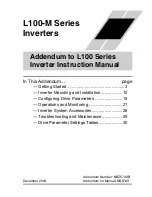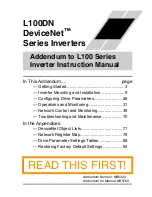
T-360
3–4
d. With the intake heater switch held in the PREHEAT position, place the ignition switch in the START position.
e. After the engine has started, continue to hold the intake heater switch in the PREHEAT position until the
engine develops sufficient oil pressure to close the oil pressure safety switch (approximately 5 seconds).
When released, the intake heater switch will automatically return to the OFF position and the heater will
remain energized for 3 minutes.
2. Units with Auto Start
a. Make sure that CB-1 is in the OFF position.
b. Hook up the 460 volt cable from the refrigerated unit to the Genset receptacle.
c. Place the Ignition switch (IGN) in the RUN position.
d. If the low coolant sensor (LCS) is immersed in coolant, the auto restart module will energize the heater
for 30 seconds and the safety buzzer will sound. After the 30 second delay, the unit will attempt to start.
3.3.3
Post-Start Inspection
1. Allow the Genset unit to run for at least 2 minutes.
2. Turn on CB-1.
3. Check generator output with a volt meter, voltage output at start up with no load at 50Hz operation should be:
Voltage output may vary and fall with ISO specifications based on ambient (Refer to
)
4. Start refrigeration unit.
5. Run engine 10 minutes (check total time meter operation).
6. Listen for abnormal bearing noise (AC generator).
7. Check fuel lines, lube oil lines, and filters for leaks.
8. Check exhaust system for leaks.
3.3.4
Stopping Instructions
1. Place CB-1 in the OFF position.
2. Place the ignition switch in the OFF position.
3.4
SEQUENCE OF OPERATION WARNING
Beware of moving poly V-Belt and belt driven components.
1. Standard Units:
With the intake heater switch (HS) held in the ON position, current flows through the ammeter to the intake
heater. While the heater is on, the ammeter will show a 42-amp draw.
A second set of contacts also energizes the safety relay (S).
If the high water temperature switch (HWT) opens to break the safety relay ground connection, the safety
relay will not energize, and the engine will not start.
To start the engine, the ignition switch (IGN) is held in the START position. With the switch in the START
position, current flows to the start solenoid (SS), through the SS contacts to the starter motor (SM). Current
then flows to the intake heater timer, intake heater relay (HR) and to the heater, while simultaneously power-
ing the electronic governor module (EG), fuel solenoid (FS), and engine speed sensor (ESS).
The starter motor turns over the engine resulting in pumping of fuel to the engine cylinders by the injection
pump. This fuel is ignited by heat of compression; thus starting the engine. When the engine has developed suf-
ficient oil pressure, the low oil pressure switch (LOP) contacts close to maintain power to the safety relay (S).
Once the engine has started, the intake heater (IH) will remain energized for 3 minutes.
The ignition switch (IGN) will be released. The intake heater switch (HS) will be held for 5 seconds, then released
after the ignition switch is released. When the START switch is released, the starter will be disengaged.
With the engine running, the battery charger provides DC power to operate the control system and charge
the battery.
Summary of Contents for Carrier Transicold 69UG15
Page 2: ......
Page 4: ......
Page 12: ......
Page 36: ......
Page 64: ......
Page 66: ...T 360 6 2 Figure 6 2 Schematic Diagram PIDs prior to UG2019 62 11725 0...
Page 67: ...6 3 T 360 Figure 6 3 Schematic High Voltage Circuitry PIDs prior to UG2019...
Page 68: ...T 360 6 4 Figure 6 4 Schematic Diagram Legend PIDs UG2019 and Up 62 04233 00...
Page 69: ...6 5 T 360 Figure 6 5 Schematic Diagram PIDs UG2019 and Up 62 04233 00...
Page 70: ...T 360 6 6 Figure 6 6 Schematic High Voltage Circuitry 7 Wire Generator PID UG2019 62 04232 00...
Page 72: ...T 360 6 8...
Page 75: ......
















































